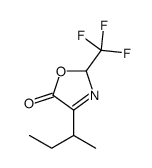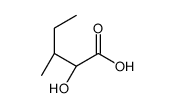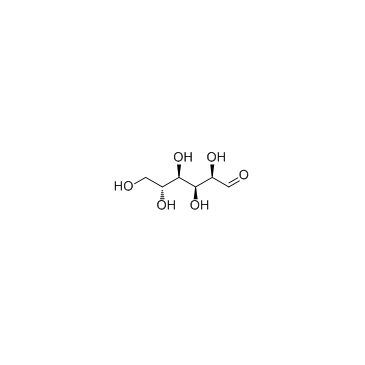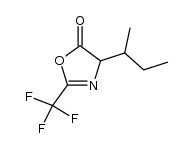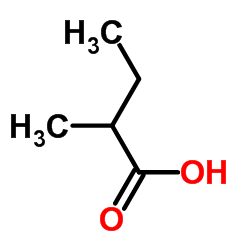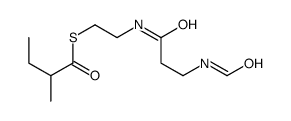1460-34-0
| Name | 3-methyl-2-oxovaleric acid |
|---|---|
| Synonyms |
EINECS 215-955-0
MFCD00002582 (3S)-3-Methyl-2-oxopentanoic acid 2-KETO-3-METHYLVALERIC ACID Pentanoic acid, 3-methyl-2-oxo-, (3S)- 2-Oxo-3-methylvaleric acid 3-METHYL-2-OXOVALERIC ACID METHYLETHYLPYRUVIC ACID |
| Description | 3-Methyl-2-oxovaleric acid is a neurotoxin, an acidogen, and a metabotoxin, and also an abnormal metabolite that arises from the incomplete breakdown of branched-chain amino acids. |
|---|---|
| Related Catalog | |
| Target |
Human Endogenous Metabolite |
| Density | 1.1±0.1 g/cm3 |
|---|---|
| Boiling Point | 190.5±9.0 °C at 760 mmHg |
| Melting Point | 42°C |
| Molecular Formula | C6H10O3 |
| Molecular Weight | 130.142 |
| Flash Point | 82.2±0.0 °C |
| Exact Mass | 130.062988 |
| PSA | 54.37000 |
| LogP | 0.17 |
| Vapour Pressure | 0.2±0.8 mmHg at 25°C |
| Index of Refraction | 1.438 |
| Storage condition | Refrigerator |
|
Section I.Chemical Product and Company Identification Chemical Name 3-Methyl-2-oxovaleric Acid Portland OR Synonym 2-Keto-3-methyl-n-pentanoic Acid Chemical Formula CH 3 CH 2 CH(CH 3 )COCOOH
CAS Number 1460-34-0 (International) Section II.Composition and Information on Ingredients Chemical NameCAS Number Percent (%)TLV/PELToxicology Data 3-Methyl-2-oxovaleric AcidMin. 90.0Not available.Not available. 1460-34-0 (Tit.) Section III.Hazards Identification Acute Health Effects Irritating to eyes and skin on contact. Inhalation causes irritation of the lungs and respiratory system . Inflam m ation of the eye is characterized by redness, w atering, and itching. Skin inflam m ation is characterized by itching, scaling, reddening, or, occasionally, blistering. Follow safe industrial hygiene practices and always wear proper protective equipment when handling this compound. Chronic Health EffectsCARCINOGENIC EFFECTS : Not available. MUTAGENIC EFFECTS : Not available. TERATOGENIC EFFECTS : Not available. DEVELOPMENTAL TOXICITY : Not available. Repeated or prolonged exposure to this compound is not known to aggravate existing medical conditions. Section IV.First Aid Measures Eye Contact C heck for and rem ove any contact lenses. In case of contact, im m ediately flush eyes w ith plenty of w ater for at least 15 minutes. Get medical attention. Skin Contact In case of contact, im m ediately flush skin w ith plenty of w ater. Rem ove contam inated clothing and shoes. W ash clothing before reuse. Thoroughly clean shoes before reuse. Get medical attention. Inhalation If the victim is not breathing, perform m outh-to-m outh resuscitation. Loosen tight clothing such as a collar, tie, belt or w aistband. If breathing is difficult, oxygen can be adm inistered. Seek m edical attention if respiration problem s do not improve. Ingestion IN D U C E V O M ITIN G by sticking finger in throat. Low er the head so that the vom it w ill not reenter the m outh and throat. Loosen tight clothing such as a collar, tie, belt or w aistband. If the victim is not breathing, perform m outh-to-m outh resuscitation. Exam ine the lips and m outh to ascertain w hether the tissues are dam aged, a possible in dication that the toxic material was ingested; the absence of such signs, however, is not conclusive. Section V.Fire and Explosion Data Auto-Ignition FlammabilityNot available. May be combustible at high temperature. Flash PointsFlammable Limits Not available. Not available. Combustion Products These products are toxic carbon oxides (CO, CO2 ). Fire Hazards Not available. Explosion Hazards Risks of explosion of the product in presence of mechanical impact: Not available. Risks of explosion of the product in presence of static discharge: Not available. Fire Fighting Media SMALL FIRE: Use DRY chemical powder. and InstructionsLARGE FIRE: Use water spray, fog or foam. DO NOT use water jet. Consult with local fire authorities before attempting large scale fire-fighting operations. Continued on Next Page 3-Methyl-2-oxovaleric Acid Section VI.Accidental Release Measures Spill Cleanup Irritating material. InstructionsU se a shovel to put the m aterial into a convenient w aste disposal container. Finish cleaning the spill by rinsing any contam inated surfaces w ith copious am ounts of w ater. C onsult federal, state, and/or local authorities for assistance on disposal. Section VII.Handling and Storage Handling and Storage IRRITA N T. REFRIG ERA TE. K eep aw ay from heat. M ech anical exhaust required.W hen not in use, tightly seal the container and store in a dry, cool place. Avoid excessive heat and light. Do not breathe dust. Information Always store away from incompatible compounds such as oxidizing agents. Section VIII.Exposure Controls/Personal Protection Engineering Controls U se process enclosures, local exhaust ventilation, or other engineering controls to keep airborne levels below recom m ended exposure lim its. If user operations generate dust, fum e or m ist, use ventilation to keep exposure to airborne contaminants below the exposure limit. Personal Protection Splash goggles. Lab coat. D ust respirator. Boots. G loves. Suggested protective clothing m ight not be sufficient; consult a specialist BEFORE handling this product. Be sure to use a MSHA/NIOSH approved respirator or equivalent. Exposure Limits Not available. Section IX.Physical and Chemical Properties Physical state @ 20°CSolubility Solid. (White Lumps.) Not available. Specific GravityNot available. Molecular WeightPartition Coefficient 130.14 Not available. Boiling PointVapor Pressure 84°C (183.2°F) @ 18 mmHgNot applicable. Melting PointVapor Density 42°C (107.6°F)Not available. Refractive IndexVolatility Not available.Not available. Critical TemperatureOdor Not available.Not available. ViscosityTaste Not available.Not available. Section X.Stability and Reactivity Data Stability This material is stable if stored under proper conditions. (See Section VII for instructions) Conditions of Instability Avoid excessive heat and light. Incompatibilities Reactive with oxidizing agents. Section XI.Toxicological Information RTECS Number Not available. Routes of Exposure Eye Contact. Ingestion. Inhalation. Toxicity Data Not available. Chronic Toxic EffectsCARCINOGENIC EFFECTS : Not available. MUTAGENIC EFFECTS : Not available. TERATOGENIC EFFECTS : Not available. DEVELOPMENTAL TOXICITY : Not available. Repeated or prolonged exposure to this compound is not known to aggravate existing medical conditions. Acute Toxic Effects Irritating to eyes and skin on contact. Inhalation causes irritation of the lungs and respiratory system . Inflam m ation of the eye is characterized by redness, w atering, and itching. Skin inflam m ation is characterized by itching, scaling, reddening, or, occasionally, blistering. Follow safe industrial hygiene practices and always wear proper protective equipment when handling this compound. Continued on Next Page 3-Methyl-2-oxovaleric Acid Section XII.Ecological Information Ecotoxicity Not available. Environmental Fate Not available. Section XIII.Disposal Considerations Waste DisposalRecycle to process, if possible. C onsult your local regional authorities. You m ay be able to dissolve or m ix m aterial w ith a com bustible solvent and burn in a chem ical incinerator equipped w ith an afterburner and scrubber system . O bserve all federal, state and local regulations when disposing of the substance. Section XIV.Transport Information DOT Classification Not a DOT controlled material (United States). PIN Number Not applicable. Proper Shipping Name Not applicable. Packing Group (PG) Not applicable. DOT Pictograms Section XV.Other Regulatory Information and Pictograms TSCA Chemical Inventory T h is p r o d u c t is NOT o n t h e E P A T o x ic S u b s t a n c e s C o n t r o l A c t (T S C A ) in v e n t o r y . T h e f o llo w in g n o t ic e s a r e r e q u ir e d b y 4 0 (EPA)CFR 720.36 (C) for those products not on the inventory list: (i) These products are supplied solely for use in research and developm ent by or under the supervision of a technically qualified individual as defined in 40 CFR 720.0 et sec. (ii) The health risks of these products have not been fully determ ined. A ny inform ation that is or becom es available w ill be supplied on an MSDS sheet. WHMIS Classification Not available. Not available. (Canada) EINECS Number (EEC) 215-955-0 EEC Risk Statements R36/37/38- Irritating to eyes, respiratory system and skin. Japanese Regulatory Data ENCS No. (2)-1503 Section XVI. Version 1.0 Validated on 3/1/2007. SECTION 16 - ADDITIONAL INFORMATION N/A |
| Hazard Codes | Xi: Irritant; |
|---|---|
| Risk Phrases | R36/37/38 |
| Safety Phrases | S26-S36/37/39-S36 |
| Precursor 8 | |
|---|---|
| DownStream 7 | |

